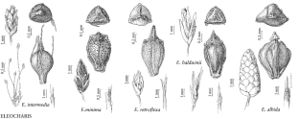Eleocharis retroflexa
Symb. Antill. 2: 165. 1900.
Plants annual, tufted, mat-forming, often stoloniferous, sometimes entirely vegetative; rhizomes absent. Culms erect, ascending or arching, pentagonal, sulcate, 1.5–10 cm × 0.2–0.3 mm [larger], soft. Leaves: distal leaf-sheaths persistent or disintegrating, pale-brown to green, red-spotted [mostly redbrown], membranous; apex acuminate. Spikelets: basal spikelets usually present, bisexual; often proliferous, ellipsoid or obovoid, laterally compressed, 1.7–3.9 × 1.2–2 mm, apex acute; proximal scale empty or with a flower, deciduous, amplexicaulous, similar to floral scales (sometimes 2.4–2.9 mm); subproximal scale with a flower; floral scales clearly distichous, 2–6 [or more], 4–6 per mm of rachilla, pale-brown [marked redbrown], ovate or elliptic, 1.8–2.5 × 0.8–1.4 mm, membranous, apex rounded to obtuse, midribs green, keeled. Flowers: perianth bristles 6, colorless or pale-brown, shorter than achenes; spinules not evident at 45X; stamens 3; anthers (0.55–) 0.7 mm; styles 3-fid. Achenes stramineous (to cream), obovoid, trigonous or subterete, not compressed, angles prominent, 0.8 × 0.5–0.55 mm, apex not constricted proximal to tubercle, coarsely cancellate or honeycomb-reticulate at 10–15X. Tubercles redbrown, pyramidal, trigonous, proximally clearly to obscurely 3-lobed, lobes decurrent on achene angles, 0.3–0.35 × 0.3–0.4 mm.
Phenology: Fruiting summer.
Habitat: Freshwater ponds, stream banks, marshes, sandy or muddy soils
Elevation: 0–10 m
Distribution

Ala., Mexico, West Indies, Bermuda, Central America, South America, Asia (including Indonesia), Pacific Islands, Australia
Discussion
We have seen only one collection of Eleocharis retroflexa from the flora area (Mobile, Alabama, in 1896, US). Other populations are likely in the United States Gulf States. The broad-shouldered, strongly sculptured achenes, trilobed, decurrent tubercles, and basal spikelets are distinctive.
Selected References
None.
Lower Taxa
"shortened" is not a number.
